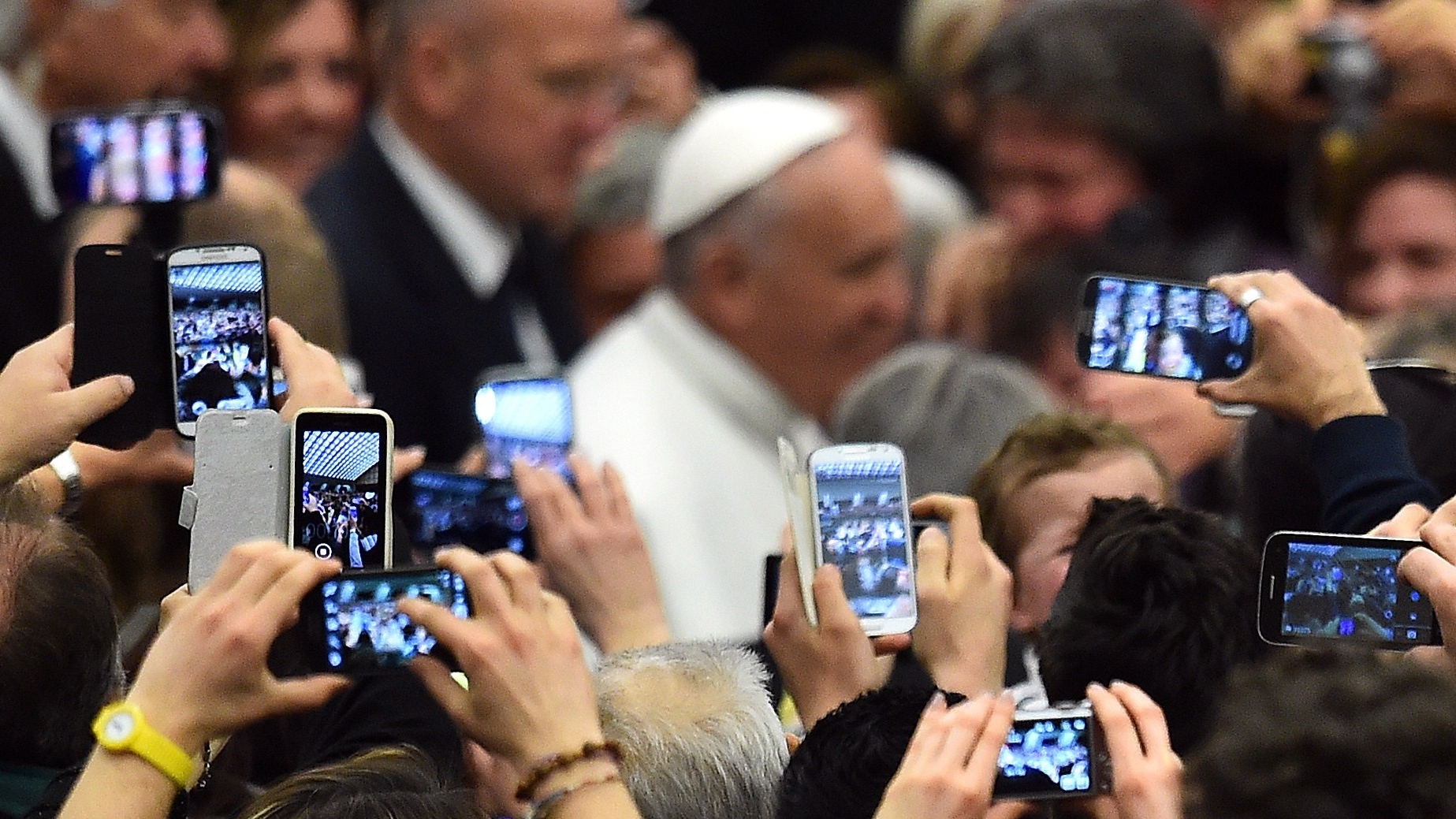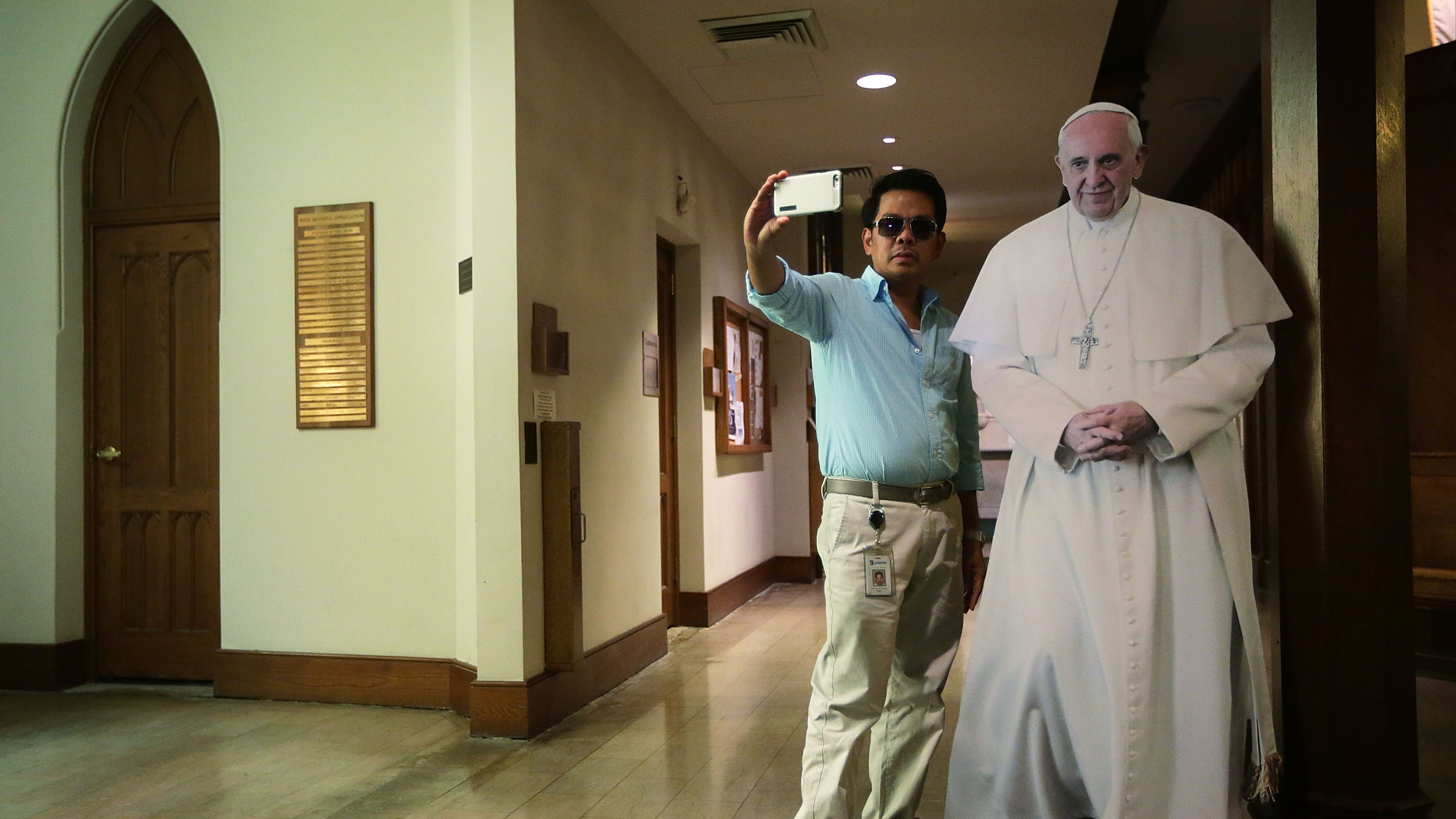
Gabriel Bouys/AFP/Getty Images
The Vatican may still announce a new pope with a smoke signal, but when it comes to connecting with his flock, Pope Francis is just a click away.
He’s called the Internet a “gift from God,” participated in Google Hangouts and fully embraced Twitter where every few days he broadcasts messages of mercy and forgiveness in 140 characters or less.
The archbishop who helped launch the Vatican’s Twitter feeds and YouTube channel says that if the church wants to keep up with the modern world – at least in terms of evangelizing – it needs to embrace social media. Archbishop Claudio Celli, head of the Pontifical Council for Social Communications, told journalists in New York last May:
“In our church we are always fishing inside the aquarium,” he said. “The majority of fish are outside the aquarium.” Unless the church engages with digital media, he said, “we will wind up talking to ourselves.”
The Pope App. Launched in 2013 under Pope Benedict, it’s pretty much a one-stop-shop for Vatican news basics. Users can check in on live streaming of papal events and video feeds from the Vatican’s six webcams, follow the pope’s Twitter feeds and read daily homilies and speeches.
Popemoji. Yes, Pope Francis has his own set of keyboard cartoons created in advance of his trip to Washington, D.C., New York and Philadelphia next week. They feature an affable Pope Francis eating a Philly cheese steak, hanging out in a New York taxicab and playing both soccer and American football.
The Popemoji is part of a larger social media effort coordinated by Aleteia USA, a Christian media company, to reach out to younger Catholics during Pope Francis’ U.S. visit. It is a multi-platform approach that goes by the handle @PopeIsHope. From Fortune:
The campaign has enlisted a “digital street team” of 60 digital strategists, content creators and “real time community managers,” 35 of whom will be publishing content on the ground at the Pope’s appearances. The rest will work out of the “Pope is Hope social listening center,” located inside a homeless shelter in Philadelphia.
Using the hashtag #goodiswinning, the team has been posting about acts of mercy and kindness, and it will continue to report dispatches on those themes during the pope’s U.S. visit to the big social media platforms like Instagram, Twitter, Snapchat, Vine, Facebook and Periscope. There will also be an effort to monitor social streams and interact with millennials to see what does and doesn’t resonate – and then report back to the church.
The campaign is led by Kathleen Hessert, who, as head of Sports Media Challenge, counts athletes and entertainers as clients. “Our effort is to reach out to milennials, who are open to listening to the pope and the church like they never have before,” she tells NPR. They’re seeking out what she calls the “unchurched” — and meeting them where they are: online.

Alex Wong/Getty Images
“This whole campaign is not about creating buzz. It’s about opening people’s minds and hearts to what Pope Francis has to say and his approach and driving them to act,” she says.
Twitter. It’s Twitter where Francis has really become a star. The reach of his tweets and retweets have made him the most influential world leader on Twitter.
Michael O’Loughlin, author of The Tweetable Pope, explains Pope Francis’ approach in a recent interview with AFP:
He has lent his moral voice to a range of causes, such as campaigns to highlight Christian persecution, efforts to stop wars, calling attention to environmental degradation and more.
The pope waded into the intense debate about inequality with a tweet sent in April 2014 that said simply, “Inequality is the root of social evil.”
When the pope released his encyclical about the environment in June, he was aware that most people won’t dive into a 200-page document. So he used a “Twitterbomb,” tweeting out the highlights every hour for 24 hours. This helped his message reach more people, directly.
Twitter is a tool to get a message out, whether that message is liberal or conservative or somewhere in the middle, and Pope Francis is taking his message to where most people will hear it: online.
His tweets as a whole are complex and surprising, just like the pope himself. Francis speaks in sound-bites, by which I mean he’s able to cut to the heart of the matter and offer complex, inspiring and challenging messages that people will remember and think about.
The pope has more than 23 million followers on nine different language accounts. His Spanish language account has the most, with nearly 10 million followers, followed by the English language version with a little more than 7 million followers. His reach may be long thanks to frequent retweeting, but in terms of followers, he trails President Barack Obama, who has 64 million followers, Justin Bieber, who has 67.5 million followers and Katy Perry, who has the most followers at 75 million.
The pope’s most popular tweets on @pontifex were in Tagalog while he visited the Philippines earlier this year. (Translated to English: The Philippines is proof of youth and vitality of the Church.)
According to O’Loughlin, Pope Francis is involved in crafting the messages, but he’s not actually writing them or tapping the tweet button. In an interview with NPR’s Scott Simon, O’Loughlin says:
“I was told that he has a small handful of advisers who talk to the Pope, Pope Francis tells them which themes and messages he wants communicated on social media, and they write out the messages in either Spanish or English or Italian, and bring those sheets of paper to him and Pope Francis signs off on every tweet.”
Student interns from Villanova University have helped the Vatican craft its social media efforts, including the original launch of the Twitter feeds and its Instagram feed.
https://instagram.com/p/1ArO87j_q1/
9(MDEwMjQ0ODM1MDEzNDk4MTEzNjU3NTRhYg004))
Read Original Article – Published SEPTEMBER 19, 2015 5:47 PM ET
Pope Francis’ Digital Reach Helps Put Him In Your Pocket
